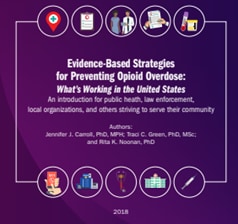Policy Approaches to Preventing Drug Overdose

A drug is any substance that can change how a person’s body and mind work. Drug overdose is injury to the body that happens when a drug is taken in excessive amounts. An overdose can be fatal or nonfatal. Opioids, particularly illicitly manufactured fentanyl, are currently the main driver of drug overdose deaths.1,2 However, the drug overdose epidemic continues to evolve and is becoming more complex through an increasing range of drugs, such as synthetic opioids (e.g., illicitly manufactured fentanyls) and stimulants, and the use of more than one substance at a time (called polysubstance use).
In 2020, almost 92 thousand people died from drug overdose, making it a leading cause of injury-related death in the United States.2
The U.S. economic cost of opioid use disorder and fatal opioid overdose during 2017 alone totaled over $1 trillion.3
For at least 3 in 5 overdose deaths, there was a missed opportunity to link the person to preventive care before an overdose or to implement life-saving actions.4
More information about the occurrence and impact of overdose is available here.
CDC’s Evidence-Based Strategies for Preventing Opioid Overdose: What’s Working in the United States highlights ten evidence-based strategies that are actions that states and jurisdictions can take today to prevent overdoses tomorrow. One of the strategies highlighted is Syringe Services Programs (SSPs), a harm reduction approach that can help prevent overdoses by facilitating access to and uptake of services and interventions for reducing overdose, enhancing health and wellbeing, and improving public health and public safety.
- Allow SSPs to operate
- Require SSPs to facilitate access to substance use disorder (SUD) treatment services
- Require SSPs to facilitate access to naloxone (a life-saving medication that can reverse an overdose from opioids)
- People who use SSPs show high readiness to reduce or stop their drug use.5
- SSP participants are 5 times more likely to enter drug treatment and 3.5 times more likely to cease injecting compared to those who don’t utilize these programs.6
- Nearly 30 years of research has shown that comprehensive SSPs are safe, effective, and cost saving, do not increase illegal drug use or crime, and play an important role in reducing the transmission of viral hepatitis, HIV, and other infections.7, 8
SSPs save lives by lowering the likelihood of deaths from overdoses.9

The Office of National Drug Control Policy, a component of the Executive Office of the President, funded the Legislative Analysis and Public Policy Association (LAPPA) to conduct a summary [149 pages] of state SSP laws. The data below are sourced from that summary, which is current to June 2022, with some adjustments based on direct CDC review of the policies.
Some states have enacted laws that prohibit the operation of SSPs. Other states (41 and Washington DC) either explicitly authorize SSPs, have laws intended to remove legal barriers to SSP operation, or de facto enable SSPs by the absence of any relevant prohibitions.
Some states do recognize life-saving services offered by SSPs, including linkage to care and naloxone access.
Substance use disorder (SUD) treatment services must be promoted by SSPs through direct provision or referral in 26 states and Washington DC).
Naloxone services must be promoted by SSPs through direct provision or referral in 12 states.
The below graph shows when you hover above the state if SSPs can operate legally there, if it must increase access to SUD, and if it must increase access to naloxone.
1 https://www.cdc.gov/drugoverdose/deaths/index.html
2 Definition of synthetic opioid
2 https://www.cdc.gov/nchs/nvss/vsrr/drug-overdose-data.htm
3 https://www.cdc.gov/mmwr/volumes/70/wr/mm7015a1.htm
5 Bluthenthal RN, Gogineni A, Longshore D, Stein M. (2001). Factors associated with readiness to change drug use among needle-exchange users. Drug Alcohol Depend. 2001;62(3):225-230.
6 Hagan H, McGough JP, Thiede H, Hopkins S, Duchin J, Alexander ER, “Reduced injection frequency and increased entry and retention in drug treatment associated with needle-exchange participation in Seattle drug injectors”, Journal of Substance Abuse Treatment, 2000; 19:247–252.
7 Aspinall, E. J., Nambiar, D., Goldberg, D. J., Hickman, M., Weir, A., Van Velzen, E., . . . Hutchinson, S. J. (2014). Are needle and syringe programmes associated with a reduction in HIV transmission among people who inject drugs: a systematic review and meta-analysis. Int J Epidemiol, 43(1), 235- 248. doi:10.1093/ije/dyt243
8 Bernard, C. L., Owens, D. K., Goldhaber-Fiebert, J. D., & Brandeau, M. L. (2017). Estimation of the cost-effectiveness of HIV prevention portfolios for people who inject drugs in the United States: A model-based analysis. PLoS Med, 14(5). doi:10.1371/journal.pmed.1002312
9 https://www.cdc.gov/ssp/docs/Syringe-Services-Program-Infographic_508.pdf [2 pages]
The findings and conclusions in this product are those of the authors and do not necessarily represent the views of the Centers for Disease Control and Prevention.
This resource is intended to communicate succinctly and clearly about very complex policies. It is current to DATE. For comprehensive picture of a given state’s legal landscape, refer directly to current state law.
Development of this product was supported by Cooperative Agreement CDC-OT18-1802: Strengthening Public Health Systems and Services through National Partnerships to Improve and Protect the Nation’s Health.
